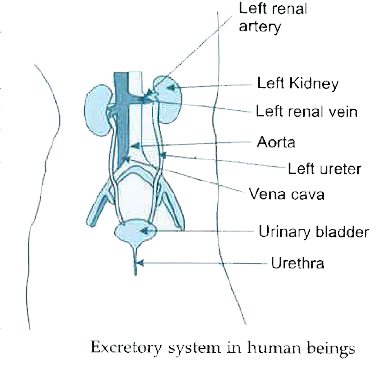BACKBONE
Step-by-Step Text Solution:
1. Definition of Backbone: The backbone, also known as the vertebral column or spine, is a crucial part of the human skeletal system. It is located along the back of the body.
2. Structure: The backbone is composed of a series of small bones that are stacked on top of each other. These small bones are referred to as vertebrae.
3. Total Number of Vertebrae: In total, there are 33 vertebrae in the human backbone. These vertebrae are arranged in a way that forms a long, flexible structure.
4. Function: The primary function of the backbone is to protect the spinal cord, which runs through a hollow tube formed by the vertebrae. The spinal cord is a vital part of the nervous system, transmitting signals between the brain and the rest of the body.
5. Diagram Representation: If we visualize the backbone, it appears as a long structure with small ring-like bones (the vertebrae) that make up its length.
Similar Questions
Each of the questions is followed by two arguments numbered I and II. You are to decide which one is strong and which is weak. Mark the answer:
(a) If argument I is strong
(b) If argument II is strong
(c ) If neither I nor II is strong
(d) If both I and II are strong
Statement: Should the degree be delinked from job?
Arguments:
Yes, because such a step would discourage students from joining universities.
II. No, because well educated people are the backbone of democracy.
View SolutionRead the following statements and identify the class of vertebrates:
This class needs to have 'moist' skin in order to breathe.
This class does not have scales.
This vertebrate class is unique because the members of this class breathe with either lungs, gills, or through the skin.
Animals in this vertebrate class lay eggs.
Members of this class have a backbone.
Animals in this class do not have claws and can have two or four legs.
These are cold blooded.
Some animals in this class are unique, as they are born with gills and then develop lungs.
View Solution
Knowledge Check
Given below are statements on the structure of the DNA double helix.
1: The helix generally is wound clockwise.
2: Purines and pyrimidines are paired by different number of hydrogen bonds.
3: The two strands run in parallel polarity.
4: The sugar in DNA backbone is a pentose sugar.
Which of the above statement/s is/are NOT TRUE?Aonly 1Bonly 2Conly 3Donly 2 and 4Which of the following statements are related to the structure of double helical DNA ?
I.The helix makes one complete spiral turn every 34 A.
II. The diameter of the helix is 20 A
III.The distance between adjacent nucleotide is 3.4 A.
IV. Each strand of helix has a backbone made up of alternating ricbose sugar and phosphate .
V. The two adjacent sugar molecules joined with phosphate by phosphodiester bond.AI and IIBI,II,III and VCII and IVDIII, IV and VRead the given statements and identify the false ones among them.
I. Skeleton comprises of the skull, backbone, ribs, breast bones, shoulder, hipbones and bones in hands and legs.
II. The muscles move by alternate contraction and relaxation of bones.
III. Bones and cartilage form the skeleton of the human body.
IV. Bones have special properties, i.e. excitability, contractibility and extensibility.
The options areAI and IIBI and IllCII and IVDII and Ill
Answer question numbers (a) - (d) on the basis ofyour understading of the following paragraph and the related studied concepts :
The excretory system of human beings includes a pair of kidneys, a pair of ureters, a urinary bladder and a urethra. Kidneys are located in the abdomen, one on either side of the backbone. Urine produced in the kidneys passes through the ureters into the ureters into urinary bladder where it is stored until it is released through the urethra.
(a) Between Renal artery and Vera cava (Renal Vein) which one carriers more impurities ?
(b) How's the expulsion of urine regulated ?
(c) How frequently is urine produced and sent into the urinary bladder ? (d) How is urine production is human body different from dialysis, though both the procedurers are helping in removal of impurities from the body ?

View SolutionEach of the following items in this section consists of a sentence, parts of which have been jumbled. These parts have been labelled as P, Q, R and S. Given below each sentence are four sequences, namely (a), (b), (c) and (d). You are required to re-arrange the jumbled parts of the sentence and mark your response accordingly.
for long andPthe backbone of IndiaQwill continue to be the sameRagriculture has beenS
View SolutionRead the given statements and identify the false ones among them.
I. Skeleton comprises of the skull, backbone, ribs, breast bones, shoulder, hipbones and bones in hands and legs.
II. The muscles move by alternate contraction and relaxation of bones.
III. Bones and cartilage form the skeleton of the human body.
IV. Bones have special properties, i.e. excitability, contractability and extensibility.
The options are
View SolutionEach of the following questions has a paragraph from which a sentence has been deleted. From the given options, choose the sentence that completes the paragraph in the most appropriate way.
Blockchain is the backbone technology on which bitcoins run.____Blockchain removes the need for using a trusted third party such as a bank to make a transaction by directly connecting the customers and suppliers. Each transaction is recorded to the ledger after verification by the network participants, mainly a chain of computers, called nodes. Blockchain today may be compared to what the Internet was in the early 1990s. White we have witnessed how the 'Internet of Information' has changed our society over the past two decades, we are now entering a phase where blockchain may do the same by ushering in a new paradigm comparing 'Internet of Trust' and 'Internet of, as per a Deloitte and Assocham study.
View Solution
